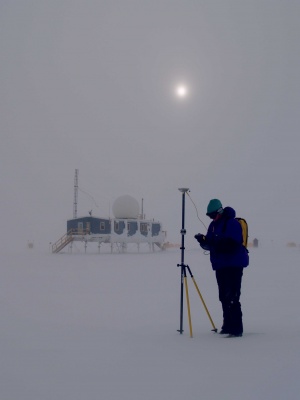If you wish to contribute or participate in the discussions about articles you are invited to contact the Editor
Real Time Kinematics
| Fundamentals | |
|---|---|
| Title | Real Time Kinematics |
| Edited by | GMV |
| Level | Basic |
| Year of Publication | 2011 |
With origin dating back to the mid-1990s, Real Time Kinematics (RTK) is a differential GNSS technique which provides high positioning performance in the vicinity of a base station. The technique is based on the use of carrier measurements and the transmission of corrections from the base station, whose location is well known, to the rover, so that the main errors that drive the stand-alone positioning cancel out. A RTK base station covers a service area spreading about 10 or 20 kilometres, and a real time communication channel is needed connecting base and rover. RTK, which achieves performances in the range of a few centimetres, is a technique commonly used in survey applications.[1][2]
Introduction RTK
Real Time Kinematics (RTK) is a differential GNSS technique originated in the mid-1990s that provides high performance positioning in the vicinity of a base station.
From an architectural point of view, RTK consists of a base station, one or several rover users, and a communication channel with which the base broadcasts information to the users at real time.
The technique is based in the following high-level principles:
- TBD
The RTK technique consists on a rover user that applies real-time corrections provided by a base station. In the classical DGNSS Technique, there are also 2 receivers, one at a known location (base station) and one at an unknown position, that see the same GNSS satellites in common. By fixing the location of the base station, the other location may be found either by computing corrections to the position of the unknown receiver or by computing corrections to the pseudoranges. In the classical DGNSS technology, only corrections to C/A code pseudoranges are being transmitted, which brings rover positional errors down to values about 1 m for distances between rover and base station of a few tens of kilometers.[2]
The military-only P(Y) signal sent by the same satellites is clocked by receivers ten times as fast, so with similar techniques the receiver will be accurate to about 30 cm. Therefore, in RTK system using the satellite's carrier phase as its signal, the improvement in accuracy is potentially very high if one continues to assume a 1% accuracy in locking. The difficulty of the use of carrier phase data comes at a cost in terms of overall system complexity because the measurements are ambiguous by an integer (i.e. every cycle of the carrier is similar to every other). Therefore, the key of the RTK technique is the "Ambiguity Resolution". [2]
The first RTK Systems that were developed use a single base station and a number of rover units. The base station re-broadcasts the phase of the carrier that it measured, and the mobile units compare their own phase measurements with the ones received from the base station. This allows the units to calculate their relative position to millimeters, although their absolute position is accurate only to the same accuracy as the position of the base station. The typical nominal accuracy for these dual-frequency systems is 1 centimeter ± 2 parts-per-million (ppm) horizontally and 2 centimeters ± 2 ppm vertically. In areas with a large GPS surveying activity, the RTK Systems have evolved to Network RTK systems making use of a network of reference stations.[1][2]
The use of RTK technique is very frequent in surveying. Other applications are autodrive/autopilot systems or precision farming.[2]
RTK Related Articles
The following articles include further information about different important topics related to RTK:
Credits
Edited by GMV. Most of the information in this article includes text taken from Wikipedia with minor adaptation,[2] provided under Creative Commons Attribution-ShareAlike License.
Notes

